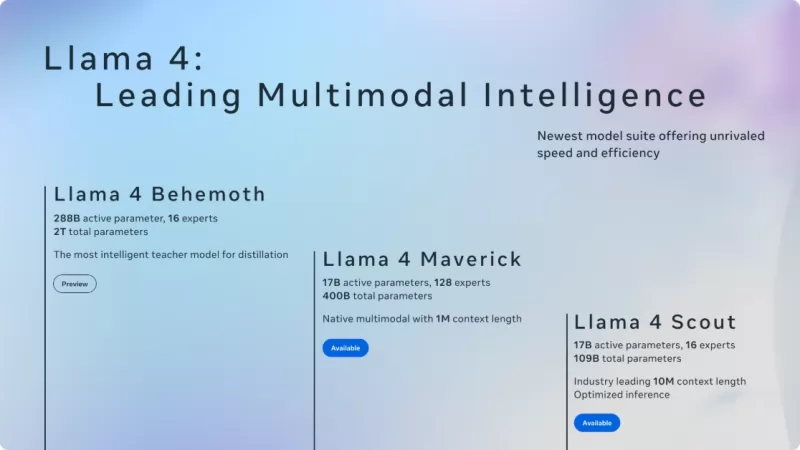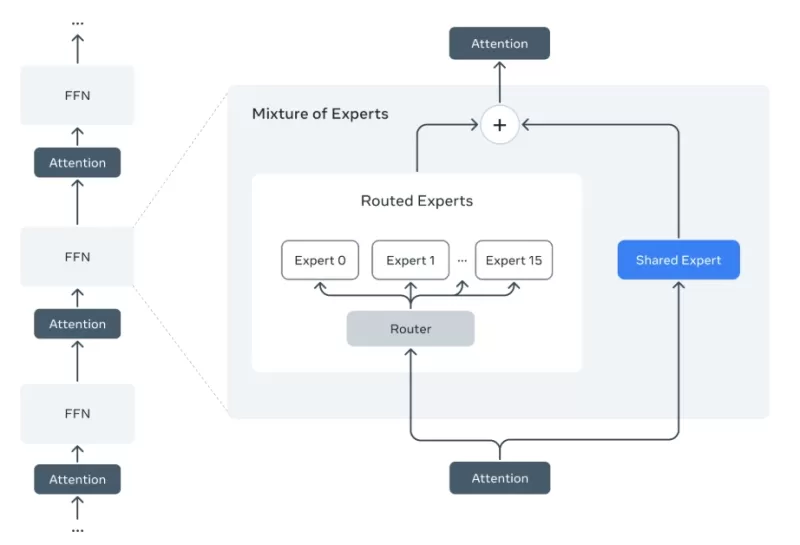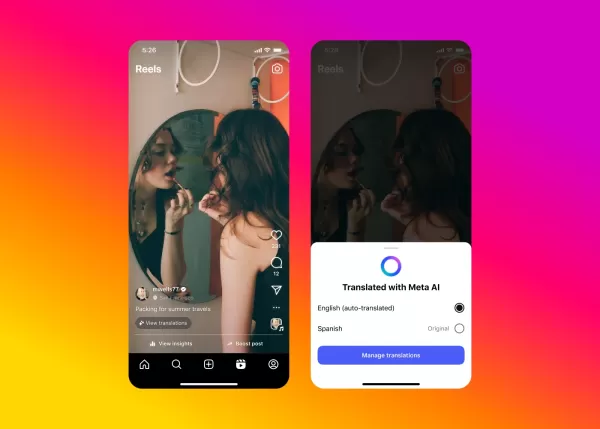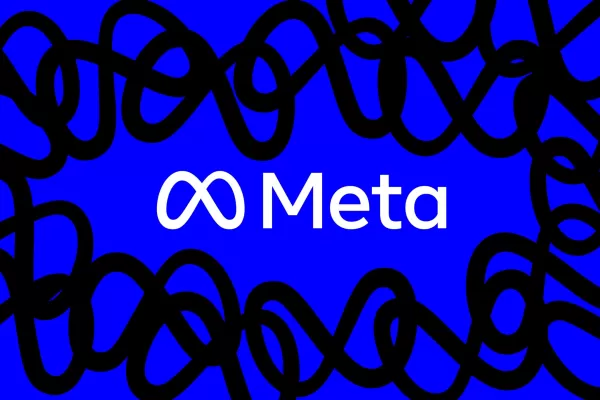Open-Source AI Fights Back with Meta's Llama 4 Release
In recent years, the AI landscape has transformed from a realm of open collaboration to one where proprietary systems reign supreme. Even OpenAI, a company that started with "open" in its name, shifted to keeping its most powerful models under wraps after 2019. Other players like Anthropic and Google followed suit, building their cutting-edge AI behind API walls, accessible only on their terms. This shift was often justified by concerns over safety and business interests, but it left many in the AI community nostalgic for the days of open-source camaraderie.
Now, the tide is turning. The spirit of open-source AI is making a comeback, spearheaded by Meta's release of the Llama 4 models. This move is a bold attempt to bring open-source AI back to the forefront, and even those traditionally secretive are taking notice. OpenAI's CEO Sam Altman recently acknowledged that the company had been "on the wrong side of history" with regard to open models and announced plans for a new "open-weight" variant of GPT-4. Clearly, open-source AI is staging a revival, and the meaning of "open" is evolving.
 (Source: Meta)
(Source: Meta)
Llama 4: Meta's Open Challenger to GPT-4o, Claude, and Gemini
Meta's unveiling of Llama 4 marks a direct challenge to the latest models from AI giants, positioning it as an open-weight alternative. Llama 4 comes in two versions available today – Llama 4 Scout and Llama 4 Maverick – each with impressive technical specs. Both are mixture-of-experts (MoE) models, which means they activate only a fraction of their parameters per query, allowing for a massive total size without skyrocketing runtime costs. Scout and Maverick each use 17 billion "active" parameters for any given input, but Scout distributes these across 16 experts (109B parameters total), while Maverick spreads them across 128 experts (400B total). The result is that Llama 4 models offer top-tier performance, along with unique advantages that even some closed models can't match.
For instance, Llama 4 Scout boasts a context window of 10 million tokens, far surpassing most competitors. This allows it to process and analyze massive documents or codebases in a single pass. Despite its scale, Scout can run efficiently on a single H100 GPU when highly quantized, suggesting that developers won't need a supercomputer to play around with it.
On the other hand, Llama 4 Maverick is optimized for peak performance. Early tests indicate that Maverick can match or even outperform leading closed models in reasoning, coding, and vision tasks. Meta is already hinting at an even larger model, Llama 4 Behemoth, currently in training, which reportedly “outperforms GPT-4.5, Claude 3.7 Sonnet, and Gemini 2.0 Pro on several STEM benchmarks.” The message is clear: open models are no longer playing second fiddle; Llama 4 is aiming for the top.
What's more, Meta has made Llama 4 immediately available for download and use. Developers can access Scout and Maverick from the official site or Hugging Face under the Llama 4 Community License. This means that anyone – from a solo developer to a large corporation – can dive into the model, fine-tune it to their specific needs, and run it on their own hardware or cloud. This is a stark contrast to proprietary models like OpenAI’s GPT-4o or Anthropic’s Claude 3.7, which are only accessible via paid APIs without access to the underlying weights.
Meta emphasizes that Llama 4's openness is about empowering users: “We’re sharing the first models in the Llama 4 herd, which will enable people to build more personalized multimodal experiences.” In essence, Llama 4 is a toolkit designed to be in the hands of developers and researchers worldwide. By releasing models that can go toe-to-toe with the likes of GPT-4 and Claude, Meta is breathing new life into the idea that top-tier AI shouldn't be locked behind a paywall.
 (Source: Meta)
(Source: Meta)
Authentic Idealism or Strategic Play?
Meta presents Llama 4 with a sense of idealism and altruism. “Our open-source AI model, Llama, has been downloaded more than one billion times,” CEO Mark Zuckerberg announced recently, adding that “open sourcing AI models is essential to ensuring people everywhere have access to the benefits of AI.” This portrayal positions Meta as a champion of democratized AI – a company willing to share its crown-jewel models for the greater good. The popularity of the Llama family supports this narrative: the models have been downloaded at an astonishing rate (jumping from 650 million to 1 billion total downloads in just a few months), and they're already in use by companies like Spotify, AT&T, and DoorDash.
Meta highlights that developers appreciate the “transparency, customizability, and security” of having open models they can run themselves, which “helps reach new levels of creativity and innovation,” compared to the opaque nature of black-box APIs. This sounds like the classic open-source software ethos (think Linux or Apache) applied to AI – a clear win for the community.
However, there's a strategic angle to Meta's openness. Meta isn't a charity, and "open-source" in this context comes with strings attached. Llama 4 is released under a special community license, not a standard permissive license – so while the model weights are free to use, there are restrictions (for example, certain high-resource use cases may require permission, and the license is “proprietary” in the sense that it's crafted by Meta). This doesn't align with the Open Source Initiative (OSI) approved definition of open source, leading some to argue that companies are misusing the term.
In practice, Meta's approach is often labeled as "open-weight" or "source-available" AI: the code and weights are shared, but Meta retains some control and doesn't disclose everything (like training data). While this doesn't reduce the utility for users, it shows that Meta is strategically open – holding onto enough control to protect itself (and perhaps its competitive edge). Many firms are applying "open source" labels to AI models while withholding key details, which undermines the true spirit of openness.
Why would Meta open up at all? The competitive landscape provides some answers. Releasing powerful models for free can quickly build a broad developer and enterprise user base – Mistral AI, a French startup, did this with its early open models to establish itself as a top-tier lab.
By flooding the market with Llama, Meta ensures its technology becomes foundational in the AI ecosystem, which can yield long-term benefits. It's a classic embrace-and-extend strategy: if everyone uses your "open" model, you indirectly set standards and perhaps even guide people towards your platforms (for example, Meta's AI assistant products leverage Llama). There's also a PR and positioning angle. Meta gets to play the role of the benevolent innovator, especially in contrast to OpenAI – which has faced criticism for its closed approach. In fact, OpenAI's change of heart on open models partly highlights how effective Meta's move has been.
After the groundbreaking Chinese open model DeepSeek-R1 emerged in January and leapfrogged previous models, Altman indicated OpenAI didn’t want to be left on the “wrong side of history.” Now OpenAI is promising an open model with strong reasoning abilities in the future, marking a shift in attitude. It's hard not to see Meta's influence in that shift. Meta's open-source stance is both genuinely aimed at broadening AI access and a strategic play to outmaneuver rivals and shape the market's future on Meta's terms.
Implications for Developers, Enterprises, and AI's Future
For developers, the resurgence of open models like Llama 4 is a welcome change. Rather than being locked into a single provider's ecosystem and fees, they now have the freedom to run powerful AI on their own infrastructure or customize it as they see fit.
This is a significant advantage for enterprises in sensitive sectors – think finance, healthcare, or government – that are cautious about feeding confidential data into someone else's black box. With Llama 4, a bank or hospital could deploy a state-of-the-art language model behind their own firewall, tuning it on private data, without sharing a token with an outside entity. There's also a cost benefit. While usage-based API fees for top models can quickly escalate, an open model has no usage toll – you pay only for the computing power to run it. Businesses that scale up heavy AI workloads stand to save considerably by choosing an open solution they can manage in-house.
It's no wonder that enterprises are showing more interest in open models; many are realizing that the control and security offered by open-source AI better meet their needs than one-size-fits-all closed services.
Developers also benefit from increased innovation. With access to the model internals, they can fine-tune and enhance the AI for niche domains (law, biotech, regional languages – you name it) in ways a closed API might never cater to. The explosion of community-driven projects around earlier Llama models – from chatbots fine-tuned on medical knowledge to hobbyist smartphone apps running miniature versions – demonstrated how open models can democratize experimentation.
However, the open model renaissance also raises important questions. Does "democratization" truly happen if only those with significant computing resources can run a 400B-parameter model? While Llama 4 Scout and Maverick lower the hardware barrier compared to monolithic models, they're still heavyweights – a point not lost on some developers whose PCs can't handle them without cloud support.
The hope is that techniques like model compression, distillation, or smaller expert variants will make Llama 4's power more accessible. Another concern is misuse. OpenAI and others long argued that releasing powerful models openly could enable malicious actors (for generating disinformation, malware code, etc.).
These concerns remain: an open-source Claude or GPT could be misused without the safety filters that companies enforce on their APIs. On the other hand, proponents argue that openness allows the community to also identify and fix problems, making models more robust and transparent over time than any secret system. There's evidence that open model communities take safety seriously, developing their own guardrails and sharing best practices – but it's an ongoing tension.
What's increasingly clear is that we're headed toward a hybrid AI landscape where open and closed models coexist, each influencing the other. Closed providers like OpenAI, Anthropic, and Google still hold an edge in absolute performance – for now. Indeed, as of late 2024, research suggested open models trailed about one year behind the very best closed models in capability. But that gap is closing fast.
In today's market, "open-source AI" no longer just means hobby projects or older models – it's now at the heart of the AI strategy for tech giants and startups alike. Meta's Llama 4 launch is a potent reminder of the evolving value of openness. It's both a philosophical stand for democratizing technology and a tactical move in a high-stakes industry battle. For developers and enterprises, it opens new doors to innovation and autonomy, even as it complicates decisions with new trade-offs. And for the broader ecosystem, it raises hope that AI's benefits won't be locked in the hands of a few corporations – if the open-source ethos can hold its ground.
Related article
 Meta's Zuckerberg Says Not All AI 'Superintelligence' Models Will Be Open-Sourced
Meta's Strategic Shift Toward Personal SuperintelligenceMeta CEO Mark Zuckerberg outlined an ambitious vision this week for "personal superintelligence" – AI systems that empower individuals to accomplish personal objectives - signaling potential cha
Meta's Zuckerberg Says Not All AI 'Superintelligence' Models Will Be Open-Sourced
Meta's Strategic Shift Toward Personal SuperintelligenceMeta CEO Mark Zuckerberg outlined an ambitious vision this week for "personal superintelligence" – AI systems that empower individuals to accomplish personal objectives - signaling potential cha
 Meta's AI Tackles Video Dubbing for Instagram Content
Meta is expanding access to its groundbreaking AI-powered dubbing technology across Facebook and Instagram, introducing seamless Video translation capabilities that maintain your authentic voice and natural lip movements.Revolutionizing Cross-Cultura
Meta's AI Tackles Video Dubbing for Instagram Content
Meta is expanding access to its groundbreaking AI-powered dubbing technology across Facebook and Instagram, introducing seamless Video translation capabilities that maintain your authentic voice and natural lip movements.Revolutionizing Cross-Cultura
 Meta AI App to Introduce Premium Tier and Ads
Meta's AI app may soon feature a paid subscription, mirroring offerings from competitors like OpenAI, Google, and Microsoft. During a Q1 2025 earnings call, Meta CEO Mark Zuckerberg outlined plans for
Comments (11)
0/200
Meta AI App to Introduce Premium Tier and Ads
Meta's AI app may soon feature a paid subscription, mirroring offerings from competitors like OpenAI, Google, and Microsoft. During a Q1 2025 earnings call, Meta CEO Mark Zuckerberg outlined plans for
Comments (11)
0/200
![RaymondAllen]() RaymondAllen
RaymondAllen
 July 27, 2025 at 9:19:05 PM EDT
July 27, 2025 at 9:19:05 PM EDT
Llama 4's release is a game-changer! Open-source AI finally gets a big win, but can it keep up with the walled gardens of OpenAI and Google? Excited to see where this goes! 🚀


 0
0
![MarkScott]() MarkScott
MarkScott
 April 17, 2025 at 12:16:48 AM EDT
April 17, 2025 at 12:16:48 AM EDT
Open-Source AI Fights Back - это потрясающе! С выпуском Llama 4 от Meta кажется, что мы возвращаемся к корням открытого сотрудничества. Это не идеально, но это шаг в правильном направлении. Продолжайте бороться за большую прозрачность, ребята! 🌟


 0
0
![GeorgeTaylor]() GeorgeTaylor
GeorgeTaylor
 April 16, 2025 at 10:10:40 PM EDT
April 16, 2025 at 10:10:40 PM EDT
Open-Source AI Fights Back é incrível! Com o lançamento do Llama 4 da Meta, parece que estamos voltando às raízes da colaboração aberta. Não é perfeito, mas é um passo na direção certa. Continuem pressionando por mais transparência, pessoal! 🌟


 0
0
![JustinAnderson]() JustinAnderson
JustinAnderson
 April 16, 2025 at 10:07:46 PM EDT
April 16, 2025 at 10:07:46 PM EDT
¡El lanzamiento de Llama 4 de Meta es un soplo de aire fresco en el mundo de la IA! Que el código abierto luche contra los gigantes propietarios es épico. 😎 Ahora podemos trastear e innovar sin restricciones. Espero que más empresas sigan el ejemplo y mantengan la IA accesible para todos! 🌍


 0
0
![BenHernández]() BenHernández
BenHernández
 April 16, 2025 at 4:30:47 PM EDT
April 16, 2025 at 4:30:47 PM EDT
MetaのLlama 4リリースはAI業界に新鮮な風を吹き込んだね!オープンソースが専有の大手に対抗するのはエピックだよ。😎 今なら制限なしでいじくり回して革新できる。もっと多くの企業がこれに続いて、AIを全員にアクセス可能にしてほしい!🌍


 0
0
![BrianBaker]() BrianBaker
BrianBaker
 April 16, 2025 at 2:56:13 PM EDT
April 16, 2025 at 2:56:13 PM EDT
Open-Source AI Fights Back is a breath of fresh air in the AI world! With Meta's Llama 4, it feels like we're getting back to the roots of open collaboration. It's not perfect, but it's a step in the right direction. Keep pushing for more transparency, guys! 🌟


 0
0
In recent years, the AI landscape has transformed from a realm of open collaboration to one where proprietary systems reign supreme. Even OpenAI, a company that started with "open" in its name, shifted to keeping its most powerful models under wraps after 2019. Other players like Anthropic and Google followed suit, building their cutting-edge AI behind API walls, accessible only on their terms. This shift was often justified by concerns over safety and business interests, but it left many in the AI community nostalgic for the days of open-source camaraderie.
Now, the tide is turning. The spirit of open-source AI is making a comeback, spearheaded by Meta's release of the Llama 4 models. This move is a bold attempt to bring open-source AI back to the forefront, and even those traditionally secretive are taking notice. OpenAI's CEO Sam Altman recently acknowledged that the company had been "on the wrong side of history" with regard to open models and announced plans for a new "open-weight" variant of GPT-4. Clearly, open-source AI is staging a revival, and the meaning of "open" is evolving.
 (Source: Meta)
(Source: Meta)
Llama 4: Meta's Open Challenger to GPT-4o, Claude, and Gemini
Meta's unveiling of Llama 4 marks a direct challenge to the latest models from AI giants, positioning it as an open-weight alternative. Llama 4 comes in two versions available today – Llama 4 Scout and Llama 4 Maverick – each with impressive technical specs. Both are mixture-of-experts (MoE) models, which means they activate only a fraction of their parameters per query, allowing for a massive total size without skyrocketing runtime costs. Scout and Maverick each use 17 billion "active" parameters for any given input, but Scout distributes these across 16 experts (109B parameters total), while Maverick spreads them across 128 experts (400B total). The result is that Llama 4 models offer top-tier performance, along with unique advantages that even some closed models can't match.
For instance, Llama 4 Scout boasts a context window of 10 million tokens, far surpassing most competitors. This allows it to process and analyze massive documents or codebases in a single pass. Despite its scale, Scout can run efficiently on a single H100 GPU when highly quantized, suggesting that developers won't need a supercomputer to play around with it.
On the other hand, Llama 4 Maverick is optimized for peak performance. Early tests indicate that Maverick can match or even outperform leading closed models in reasoning, coding, and vision tasks. Meta is already hinting at an even larger model, Llama 4 Behemoth, currently in training, which reportedly “outperforms GPT-4.5, Claude 3.7 Sonnet, and Gemini 2.0 Pro on several STEM benchmarks.” The message is clear: open models are no longer playing second fiddle; Llama 4 is aiming for the top.
What's more, Meta has made Llama 4 immediately available for download and use. Developers can access Scout and Maverick from the official site or Hugging Face under the Llama 4 Community License. This means that anyone – from a solo developer to a large corporation – can dive into the model, fine-tune it to their specific needs, and run it on their own hardware or cloud. This is a stark contrast to proprietary models like OpenAI’s GPT-4o or Anthropic’s Claude 3.7, which are only accessible via paid APIs without access to the underlying weights.
Meta emphasizes that Llama 4's openness is about empowering users: “We’re sharing the first models in the Llama 4 herd, which will enable people to build more personalized multimodal experiences.” In essence, Llama 4 is a toolkit designed to be in the hands of developers and researchers worldwide. By releasing models that can go toe-to-toe with the likes of GPT-4 and Claude, Meta is breathing new life into the idea that top-tier AI shouldn't be locked behind a paywall.
 (Source: Meta)
(Source: Meta)
Authentic Idealism or Strategic Play?
Meta presents Llama 4 with a sense of idealism and altruism. “Our open-source AI model, Llama, has been downloaded more than one billion times,” CEO Mark Zuckerberg announced recently, adding that “open sourcing AI models is essential to ensuring people everywhere have access to the benefits of AI.” This portrayal positions Meta as a champion of democratized AI – a company willing to share its crown-jewel models for the greater good. The popularity of the Llama family supports this narrative: the models have been downloaded at an astonishing rate (jumping from 650 million to 1 billion total downloads in just a few months), and they're already in use by companies like Spotify, AT&T, and DoorDash.
Meta highlights that developers appreciate the “transparency, customizability, and security” of having open models they can run themselves, which “helps reach new levels of creativity and innovation,” compared to the opaque nature of black-box APIs. This sounds like the classic open-source software ethos (think Linux or Apache) applied to AI – a clear win for the community.
However, there's a strategic angle to Meta's openness. Meta isn't a charity, and "open-source" in this context comes with strings attached. Llama 4 is released under a special community license, not a standard permissive license – so while the model weights are free to use, there are restrictions (for example, certain high-resource use cases may require permission, and the license is “proprietary” in the sense that it's crafted by Meta). This doesn't align with the Open Source Initiative (OSI) approved definition of open source, leading some to argue that companies are misusing the term.
In practice, Meta's approach is often labeled as "open-weight" or "source-available" AI: the code and weights are shared, but Meta retains some control and doesn't disclose everything (like training data). While this doesn't reduce the utility for users, it shows that Meta is strategically open – holding onto enough control to protect itself (and perhaps its competitive edge). Many firms are applying "open source" labels to AI models while withholding key details, which undermines the true spirit of openness.
Why would Meta open up at all? The competitive landscape provides some answers. Releasing powerful models for free can quickly build a broad developer and enterprise user base – Mistral AI, a French startup, did this with its early open models to establish itself as a top-tier lab.
By flooding the market with Llama, Meta ensures its technology becomes foundational in the AI ecosystem, which can yield long-term benefits. It's a classic embrace-and-extend strategy: if everyone uses your "open" model, you indirectly set standards and perhaps even guide people towards your platforms (for example, Meta's AI assistant products leverage Llama). There's also a PR and positioning angle. Meta gets to play the role of the benevolent innovator, especially in contrast to OpenAI – which has faced criticism for its closed approach. In fact, OpenAI's change of heart on open models partly highlights how effective Meta's move has been.
After the groundbreaking Chinese open model DeepSeek-R1 emerged in January and leapfrogged previous models, Altman indicated OpenAI didn’t want to be left on the “wrong side of history.” Now OpenAI is promising an open model with strong reasoning abilities in the future, marking a shift in attitude. It's hard not to see Meta's influence in that shift. Meta's open-source stance is both genuinely aimed at broadening AI access and a strategic play to outmaneuver rivals and shape the market's future on Meta's terms.
Implications for Developers, Enterprises, and AI's Future
For developers, the resurgence of open models like Llama 4 is a welcome change. Rather than being locked into a single provider's ecosystem and fees, they now have the freedom to run powerful AI on their own infrastructure or customize it as they see fit.
This is a significant advantage for enterprises in sensitive sectors – think finance, healthcare, or government – that are cautious about feeding confidential data into someone else's black box. With Llama 4, a bank or hospital could deploy a state-of-the-art language model behind their own firewall, tuning it on private data, without sharing a token with an outside entity. There's also a cost benefit. While usage-based API fees for top models can quickly escalate, an open model has no usage toll – you pay only for the computing power to run it. Businesses that scale up heavy AI workloads stand to save considerably by choosing an open solution they can manage in-house.
It's no wonder that enterprises are showing more interest in open models; many are realizing that the control and security offered by open-source AI better meet their needs than one-size-fits-all closed services.
Developers also benefit from increased innovation. With access to the model internals, they can fine-tune and enhance the AI for niche domains (law, biotech, regional languages – you name it) in ways a closed API might never cater to. The explosion of community-driven projects around earlier Llama models – from chatbots fine-tuned on medical knowledge to hobbyist smartphone apps running miniature versions – demonstrated how open models can democratize experimentation.
However, the open model renaissance also raises important questions. Does "democratization" truly happen if only those with significant computing resources can run a 400B-parameter model? While Llama 4 Scout and Maverick lower the hardware barrier compared to monolithic models, they're still heavyweights – a point not lost on some developers whose PCs can't handle them without cloud support.
The hope is that techniques like model compression, distillation, or smaller expert variants will make Llama 4's power more accessible. Another concern is misuse. OpenAI and others long argued that releasing powerful models openly could enable malicious actors (for generating disinformation, malware code, etc.).
These concerns remain: an open-source Claude or GPT could be misused without the safety filters that companies enforce on their APIs. On the other hand, proponents argue that openness allows the community to also identify and fix problems, making models more robust and transparent over time than any secret system. There's evidence that open model communities take safety seriously, developing their own guardrails and sharing best practices – but it's an ongoing tension.
What's increasingly clear is that we're headed toward a hybrid AI landscape where open and closed models coexist, each influencing the other. Closed providers like OpenAI, Anthropic, and Google still hold an edge in absolute performance – for now. Indeed, as of late 2024, research suggested open models trailed about one year behind the very best closed models in capability. But that gap is closing fast.
In today's market, "open-source AI" no longer just means hobby projects or older models – it's now at the heart of the AI strategy for tech giants and startups alike. Meta's Llama 4 launch is a potent reminder of the evolving value of openness. It's both a philosophical stand for democratizing technology and a tactical move in a high-stakes industry battle. For developers and enterprises, it opens new doors to innovation and autonomy, even as it complicates decisions with new trade-offs. And for the broader ecosystem, it raises hope that AI's benefits won't be locked in the hands of a few corporations – if the open-source ethos can hold its ground.
 Meta's Zuckerberg Says Not All AI 'Superintelligence' Models Will Be Open-Sourced
Meta's Strategic Shift Toward Personal SuperintelligenceMeta CEO Mark Zuckerberg outlined an ambitious vision this week for "personal superintelligence" – AI systems that empower individuals to accomplish personal objectives - signaling potential cha
Meta's Zuckerberg Says Not All AI 'Superintelligence' Models Will Be Open-Sourced
Meta's Strategic Shift Toward Personal SuperintelligenceMeta CEO Mark Zuckerberg outlined an ambitious vision this week for "personal superintelligence" – AI systems that empower individuals to accomplish personal objectives - signaling potential cha
 Meta's AI Tackles Video Dubbing for Instagram Content
Meta is expanding access to its groundbreaking AI-powered dubbing technology across Facebook and Instagram, introducing seamless Video translation capabilities that maintain your authentic voice and natural lip movements.Revolutionizing Cross-Cultura
Meta's AI Tackles Video Dubbing for Instagram Content
Meta is expanding access to its groundbreaking AI-powered dubbing technology across Facebook and Instagram, introducing seamless Video translation capabilities that maintain your authentic voice and natural lip movements.Revolutionizing Cross-Cultura
 Meta AI App to Introduce Premium Tier and Ads
Meta's AI app may soon feature a paid subscription, mirroring offerings from competitors like OpenAI, Google, and Microsoft. During a Q1 2025 earnings call, Meta CEO Mark Zuckerberg outlined plans for
Meta AI App to Introduce Premium Tier and Ads
Meta's AI app may soon feature a paid subscription, mirroring offerings from competitors like OpenAI, Google, and Microsoft. During a Q1 2025 earnings call, Meta CEO Mark Zuckerberg outlined plans for
 July 27, 2025 at 9:19:05 PM EDT
July 27, 2025 at 9:19:05 PM EDT
Llama 4's release is a game-changer! Open-source AI finally gets a big win, but can it keep up with the walled gardens of OpenAI and Google? Excited to see where this goes! 🚀


 0
0
 April 17, 2025 at 12:16:48 AM EDT
April 17, 2025 at 12:16:48 AM EDT
Open-Source AI Fights Back - это потрясающе! С выпуском Llama 4 от Meta кажется, что мы возвращаемся к корням открытого сотрудничества. Это не идеально, но это шаг в правильном направлении. Продолжайте бороться за большую прозрачность, ребята! 🌟


 0
0
 April 16, 2025 at 10:10:40 PM EDT
April 16, 2025 at 10:10:40 PM EDT
Open-Source AI Fights Back é incrível! Com o lançamento do Llama 4 da Meta, parece que estamos voltando às raízes da colaboração aberta. Não é perfeito, mas é um passo na direção certa. Continuem pressionando por mais transparência, pessoal! 🌟


 0
0
 April 16, 2025 at 10:07:46 PM EDT
April 16, 2025 at 10:07:46 PM EDT
¡El lanzamiento de Llama 4 de Meta es un soplo de aire fresco en el mundo de la IA! Que el código abierto luche contra los gigantes propietarios es épico. 😎 Ahora podemos trastear e innovar sin restricciones. Espero que más empresas sigan el ejemplo y mantengan la IA accesible para todos! 🌍


 0
0
 April 16, 2025 at 4:30:47 PM EDT
April 16, 2025 at 4:30:47 PM EDT
MetaのLlama 4リリースはAI業界に新鮮な風を吹き込んだね!オープンソースが専有の大手に対抗するのはエピックだよ。😎 今なら制限なしでいじくり回して革新できる。もっと多くの企業がこれに続いて、AIを全員にアクセス可能にしてほしい!🌍


 0
0
 April 16, 2025 at 2:56:13 PM EDT
April 16, 2025 at 2:56:13 PM EDT
Open-Source AI Fights Back is a breath of fresh air in the AI world! With Meta's Llama 4, it feels like we're getting back to the roots of open collaboration. It's not perfect, but it's a step in the right direction. Keep pushing for more transparency, guys! 🌟


 0
0





























